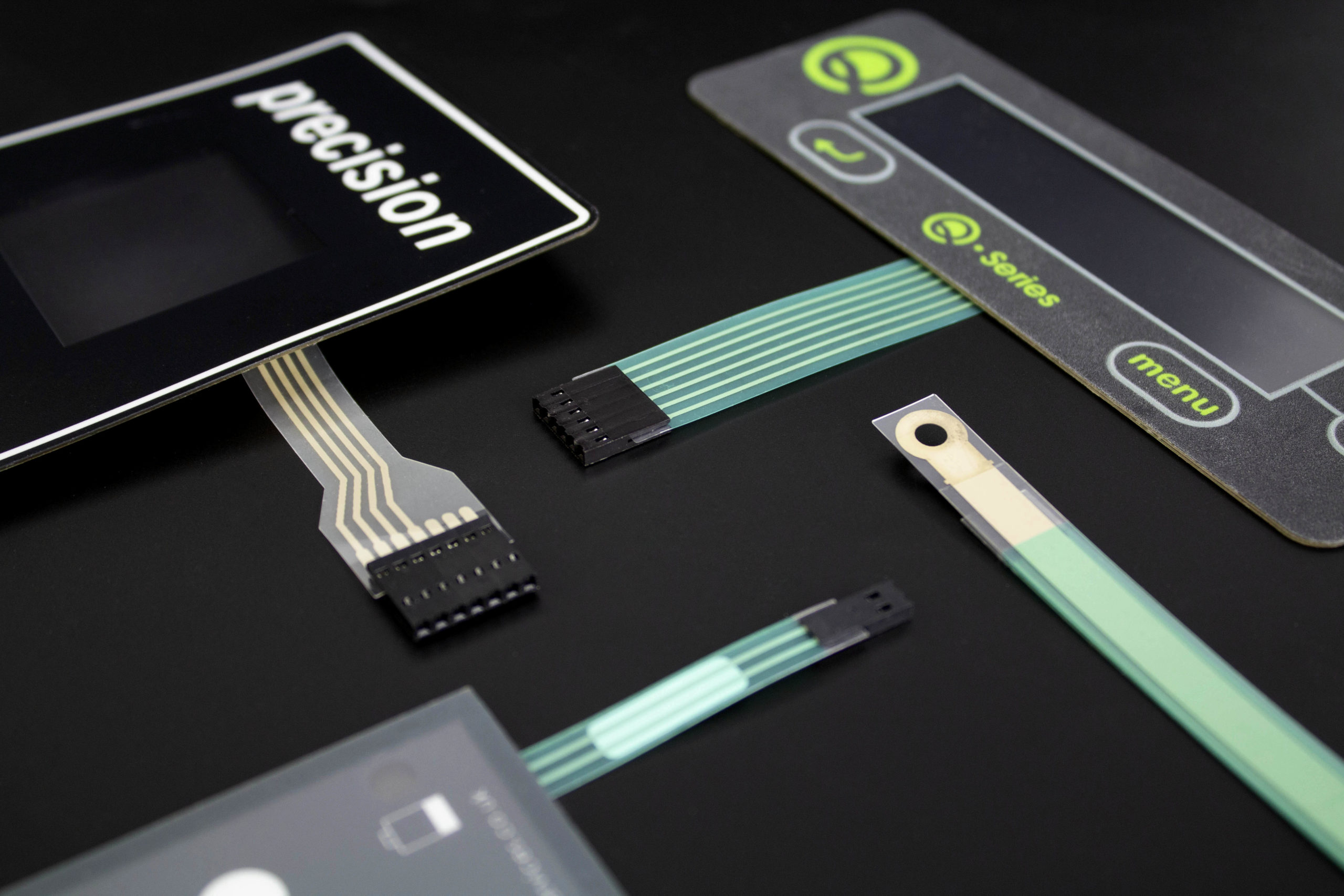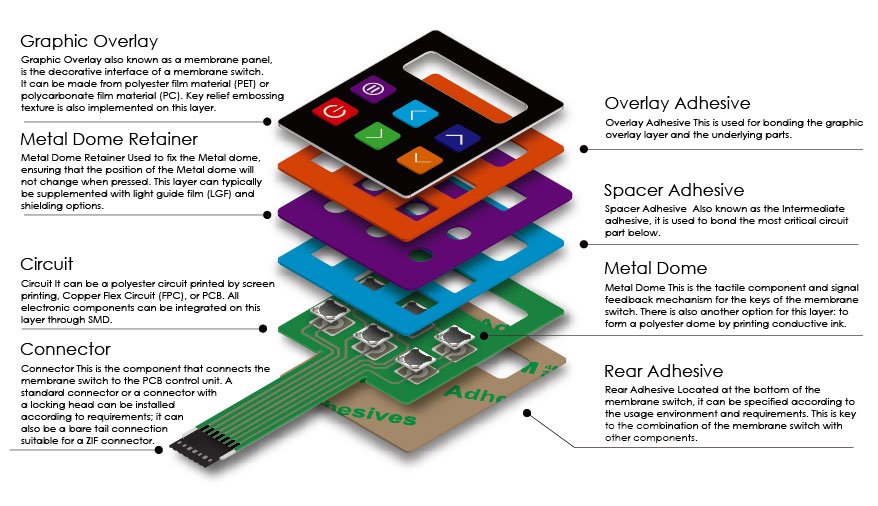Understanding the Importance of Membrane Layer Switch in Modern Electronics
Membrane layer buttons are indispensable parts in modern-day electronic tools. They use a blend of capability and design that improves customer interaction. Their light-weight and sturdy nature makes them ideal for different applications. As industries advance, the need for customization and advanced attributes grows. Comprehending just how membrane layer switches over contribute to advancement exposes their relevance in forming the future of electronics. What exists in advance for this technology?
The Basics of Membrane Layer Switch Innovation
Although commonly forgotten, membrane layer switch modern technology plays a vital role in the modern electronics landscape - membrane switch. These devices, made up of several layers, act as interface for numerous electronic items, ranging from household devices to medical devices. A typical membrane layer button consists of a visuals overlay, a spacer layer, and a circuit layer, which are diligently constructed to produce a practical interface.When stress is put on the overlay, the circuit layer is finished, allowing signals to be transferred to the device. This modern technology is understood for its flexibility, making it possible for modification in capability, layout, and form to fulfill certain user demands. In addition, membrane buttons are light-weight and thin, making them appropriate for applications where room is a premium. Their toughness and resistance to environmental variables further boost their charm, ensuring they can withstand severe problems while maintaining functionality. On the whole, membrane button technology is essential to producing user-friendly and effective electronic devices

Trick Advantages of Membrane Layer Switches
Membrane layer switches offer several crucial benefits that make them a recommended choice in numerous electronic applications. Their layout enables a compact type aspect, enabling manufacturers to create streamlined and lightweight tools. Furthermore, membrane buttons are resistant to dirt, moisture, and chemicals, which enhances their sturdiness and durability popular atmospheres. The tactile responses offered by these buttons can enhance customer experience, making them easy and user-friendly to operate.Furthermore, membrane switches can be tailored with diverse graphics and colors, permitting for distinct branding possibilities. The manufacturing procedure is generally economical, especially for high-volume production, as it reduces assembly time and streamlines style. Membrane switches over call for very little upkeep, adding to reduced general operational expenses. These advantages underscore their growing popularity in contemporary electronic devices, where integrity and easy to use interfaces are vital.

Applications Across Different Industries
The flexibility of membrane layer changes enables their prevalent adoption throughout various sectors. In the medical area, they are typically made use of in diagnostic tools and individual monitoring systems, supplying a long lasting interface immune to pollutants. The automotive market utilizes membrane layer buttons for dashboard controls, boosting individual experience with sleek styles that hold up against severe problems. In consumer electronic devices, they work as control panels for tools such as microwaves and coffee machine, offering a straightforward user interface that is easy to tidy. The aerospace market uses membrane layer buttons in cockpit controls, where dependability and room effectiveness are extremely important. Furthermore, the commercial field leverages these switches in machinery and control systems to assure durable operation sought after atmospheres. This wide range of applications underscores the versatility of membrane these details layer switches, making them integral parts in enhancing capability and individual communication throughout diverse technological landscapes.
Personalization and Style Adaptability

Future Trends in Membrane Switch Over Growth
Arising fads in membrane layer button advancement suggest a growing emphasis on enhanced functionality and integration with clever modern technologies. As customer need for much more advanced electronic tools rises, makers are concentrating on creating membrane layer switches that not only serve fundamental functional functions yet also integrate features like touch sensitivity, backlighting, and haptic feedback.Furthermore, innovations in materials are expected to boost durability and ecological resistance, making membrane layer switches ideal for varied applications in industries such as healthcare, vehicle, and consumer electronic devices. The combination of capacitive touch innovation is most likely to end up being more widespread, permitting sleeker layouts and enhanced customer interfaces. membrane switch.Additionally, the Clicking Here increase of the Internet of Points (IoT) is prompting the advancement of membrane changes that can communicate wirelessly with various other devices, boosting interconnectivity. In general, check these guys out the future of membrane layer switch modern technology appears encouraging, driven by development and the search of easy to use remedies
Often Asked Inquiries
How Do Membrane Layer Switches Compare to Typical Mechanical Switches?
Membrane buttons, being more space-efficient and using a sleek style, comparison with traditional mechanical switches that give tactile comments. The previous usually feature adjustable graphics, while the latter usually ensure durability and dependability in numerous applications.
What Materials Are Typically Made Use Of in Membrane Switch Production?
Membrane layer buttons are generally created making use of products such as polyester, polycarbonate, and published conductive inks. These materials offer toughness, adaptability, and responsiveness, making them appropriate for different applications in digital gadgets and interface.
Can Membrane Layer Changes Be Repaired or Reused?
Membrane layer buttons can commonly be repaired, particularly if small concerns develop, such as sticky failure or surface damage. Full reuse is usually limited due to put on and prospective degradation of products over time.
Exactly How Do Ecological Aspects Impact Membrane Layer Switch Performance?
Environmental factors, such as humidity, temperature level, and exposure to chemicals, substantially influence membrane layer switch efficiency. Extreme problems can lead to destruction, impacting responsiveness and longevity, eventually compromising the performance of the gadget in numerous applications.
What Is the Common Life-span of a Membrane Change?
The regular life expectancy of a membrane layer button typically varies from 1 to 5 million actuations, depending on elements such as use regularity, environmental conditions, and the products used in manufacturing, affecting sturdiness and efficiency long life. A common membrane button is composed of a graphic overlay, a spacer layer, and a circuit layer, which are carefully set up to develop a functional interface - membrane switch.When pressure is applied to the overlay, the circuit layer is finished, permitting signals to be sent to the device. The tactile comments supplied by these buttons can boost customer experience, making them intuitive and easy to operate.Furthermore, membrane layer buttons can be personalized with diverse graphics and shades, allowing for unique branding chances. As consumer demand for a lot more advanced digital tools increases, manufacturers are focusing on creating membrane switches that not just offer standard functional duties yet additionally include functions like touch level of sensitivity, backlighting, and haptic feedback.Furthermore, innovations in products are anticipated to enhance toughness and ecological resistance, making membrane switches suitable for varied applications in sectors such as medical care, vehicle, and customer electronic devices. The combination of capacitive touch innovation is likely to become more widespread, permitting for sleeker styles and improved user interfaces.Additionally, the rise of the Net of Points (IoT) is prompting the development of membrane layer changes that can communicate wirelessly with various other gadgets, improving interconnectivity. Membrane buttons, being much more space-efficient and providing a streamlined style, contrast with typical mechanical buttons that offer tactile responses
Comments on “Membrane switch in digital appliances: design considerations”